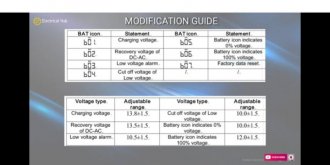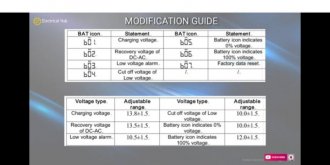Setup:
12v 1000w pure sinewave inverter with AC charging (set to mode#1 - UPS mode)
4s prismatic sinopoly 90ah (2nd hand cells)
30a/15a deligreen bms
4s capacitor type active balancer

NO SOLAR (the thing is powered by grid electricity all the time)
My load is very very small. roughly 40-60watts. 70watts max.
Blackouts are uncommon just around 2x 30-60mins blackout every month.
But every 2-3months an 8-10hour scheduled maintenance blackout do happen.
I want them to last a good 12hours of battery backup.
Now i want to get the "most life" of these lifepo4 batteries as i have used lead acid and they last just 2-3years and i am pretty feedup of replacing them.
The inverter has these options available to adjust.

Defaults are:
B1 - 13.8v
B2 - 13.6v
B3 - 12.0v
B4 - 10.8v
B5 - 10.8v
B6 - 12.0v
Do i need to change any of these?
THANK YOU
12v 1000w pure sinewave inverter with AC charging (set to mode#1 - UPS mode)
4s prismatic sinopoly 90ah (2nd hand cells)
30a/15a deligreen bms
4s capacitor type active balancer

NO SOLAR (the thing is powered by grid electricity all the time)
My load is very very small. roughly 40-60watts. 70watts max.
Blackouts are uncommon just around 2x 30-60mins blackout every month.
But every 2-3months an 8-10hour scheduled maintenance blackout do happen.
I want them to last a good 12hours of battery backup.
Now i want to get the "most life" of these lifepo4 batteries as i have used lead acid and they last just 2-3years and i am pretty feedup of replacing them.
The inverter has these options available to adjust.

Defaults are:
B1 - 13.8v
B2 - 13.6v
B3 - 12.0v
B4 - 10.8v
B5 - 10.8v
B6 - 12.0v
Do i need to change any of these?
THANK YOU




